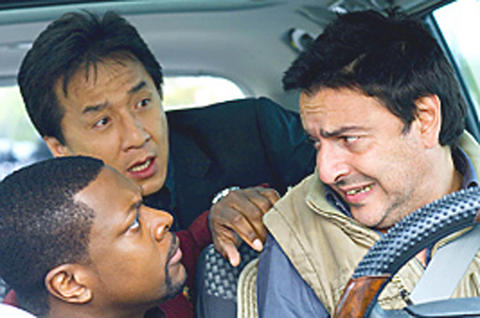Rush Hour 3, the junky, clunky, grimly unfunny follow-up to the marginally better Rush Hour 2, and the significantly finer Rush Hour, isn't the worst movie of the summer. But it's an enervating bummer nonetheless, largely because it shows so little respect for its two likable stars and its audience. Once again Jackie Chan (成龍) and Chris Tucker, playing seriously unlikely detectives, bumble and slog through muddled setups, graceless action, crude jokes and even cruder stereotypes, sacrificing themselves on the altar of the director Brett Ratner's vulgar success.
The arc of Ratner's career can be summed up entirely with numbers, namely the US$247,538,093 that Rush Hour raked into theaters worldwide; the US$328,883,178 that Rush Hour 2, made across the globe; and the mind-boggling (especially if you saw the movie) US$453,796,824 earned, again worldwide, by X Men: The Last Stand. These figures, from Variety, don't include DVD revenue, cable sales and the like, but you get the big tautological picture: Ratner has a gift for making products that companies can sell to the public, which is why he makes products. Even so, given the anonymity of these products, the credit "A Brett Ratner Film" seems largely ceremonial.
There's nothing new about any of this, yet it does bear repeating every so often, even in a movie review. Like a lot of big-ticket productions Rush Hour 3 flooded into US theater in August (gobbling up more than 3,700 of the nation's approximately 38,000 screens) and, because of its ubiquity and its brawny advertising muscle, pulled in a sizable chunk of change. Bad reviews won't make a lick of difference to its box office, though franchise fatigue might. Chan's and Tucker's star power has waned in the six years since Rush Hour 2.

PHOTO: COURTESY OF WARNER BROTHERS
Part of the reason I've strayed from discussing Rush Hour 3 is that there's not much to say about the actual movie. It's a generically crummy action flick. It's ugly. It's noisy. It's stupid. And unlike, say, Transformers, which sells militarism alongside children's toys, it doesn't raise hackles, much less blood pressure. Thus, as an object, Rush Hour 3 offers precious little of interest, although it does take a special kind of talent to make Paris, where some of the story takes place, look this uninviting. There, rather depressingly, Roman Polanski shows up wearing a mustache and a smirk to harass Chan's and Tucker's characters, who are globetrotting after some villains. Max von Sydow also pops up for a few scenes, a reminder that Ingmar Bergman really is dead.
Chan and Tucker don't get to wiggle off the hook entirely. But people have to make a living, even movie stars, and there are limited opportunities for an aging Hong Kong martial-arts giant and an eccentrically talented black comic actor. Given how much pleasure both have provided over the years, especially Chan, here's hoping they were paid by the truckload.

Wooden houses wedged between concrete, crumbling brick facades with roofs gaping to the sky, and tiled art deco buildings down narrow alleyways: Taichung Central District’s (中區) aging architecture reveals both the allure and reality of the old downtown. From Indigenous settlement to capital under Qing Dynasty rule through to Japanese colonization, Taichung’s Central District holds a long and layered history. The bygone beauty of its streets once earned it the nickname “Little Kyoto.” Since the late eighties, however, the shifting of economic and government centers westward signaled a gradual decline in the area’s evolving fortunes. With the regeneration of the once

Even by the standards of Ukraine’s International Legion, which comprises volunteers from over 55 countries, Han has an unusual backstory. Born in Taichung, he grew up in Costa Rica — then one of Taiwan’s diplomatic allies — where a relative worked for the embassy. After attending an American international high school in San Jose, Costa Rica’s capital, Han — who prefers to use only his given name for OPSEC (operations security) reasons — moved to the US in his teens. He attended Penn State University before returning to Taiwan to work in the semiconductor industry in Kaohsiung, where he

In February of this year the Taipei Times reported on the visit of Lienchiang County Commissioner Wang Chung-ming (王忠銘) of the Chinese Nationalist Party (KMT) and a delegation to a lantern festival in Fuzhou’s Mawei District in Fujian Province. “Today, Mawei and Matsu jointly marked the lantern festival,” Wang was quoted as saying, adding that both sides “being of one people,” is a cause for joy. Wang was passing around a common claim of officials of the People’s Republic of China (PRC) and the PRC’s allies and supporters in Taiwan — KMT and the Taiwan People’s Party — and elsewhere: Taiwan and

Perched on Thailand’s border with Myanmar, Arunothai is a dusty crossroads town, a nowheresville that could be the setting of some Southeast Asian spaghetti Western. Its main street is the final, dead-end section of the two-lane highway from Chiang Mai, Thailand’s second largest city 120kms south, and the heart of the kingdom’s mountainous north. At the town boundary, a Chinese-style arch capped with dragons also bears Thai script declaring fealty to Bangkok’s royal family: “Long live the King!” Further on, Chinese lanterns line the main street, and on the hillsides, courtyard homes sit among warrens of narrow, winding alleyways and